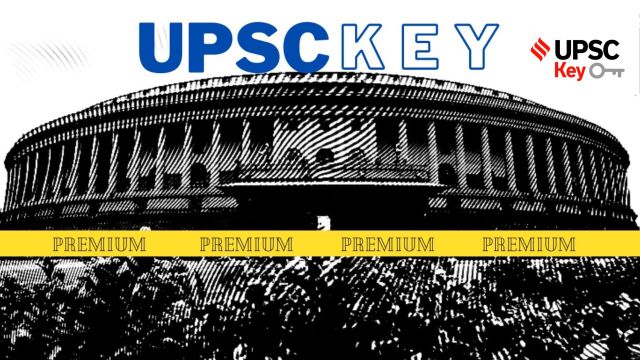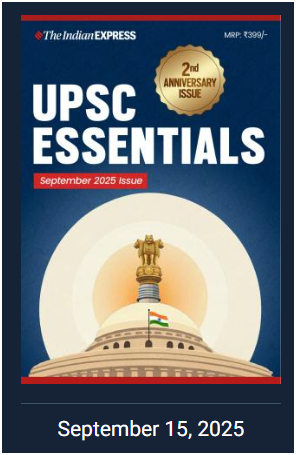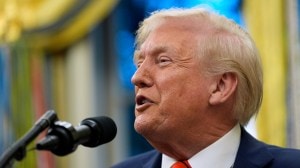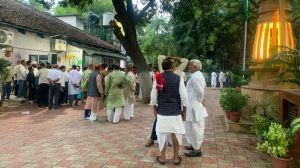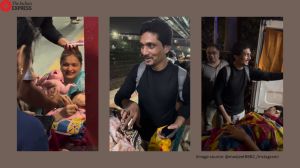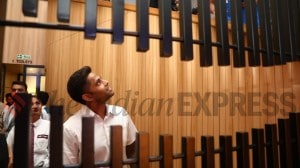
Delhi, Dhaka sign river pact, first in 25 years; Hasina praises Modi
Syllabus:
Preliminary Examination: Current events of national and international importance.
Mains Examination: General Studies II: India and its neighbourhood- relations.
Key Points to Ponder:
Story continues below this ad
• What’s the ongoing story- Visiting Bangladesh Prime Minister Sheikh Hasina said Tuesday that “as long as Prime Minister (Narendra) Modi is here, Bangladesh and India will resolve” problems between them. She said this in the context of sharing river waters as the two countries signed an interim water sharing agreement for the Kushiyara river, the first such pact between them in over 25 years — the Ganga water treaty was signed in 1996.
• Personality in News– Bangladesh Prime Minister Sheikh Hasina
• Map Work-Bangladesh
• Map Work-Kushiyara River and Teesta River (Mark both source and mouth)
• Which States of India share boundaries with Bangladesh?
• For both Delhi and Dhaka, the reinvention of the bilateral relationship has been one of the most significant successes of their recent foreign policies-Know bilateral relationship between India and Bangladesh
• Know in detail about India’s Water Disputes or rather India’s water issues with Bangladesh
Story continues below this ad
• The issue of water-sharing remains a key irritant in the bilateral relationship between India and Bangladesh-discuss
• What was the Ganga water treaty between India and Bangladesh?
• According to many experts, the Teesta river remained the most contentious issue between two India and Bangladesh- Can you elaborate further on this?
• What is the status of the Teesta dispute?
• Teesta aside, how has the relationship with Bangladesh evolved over the years?
• What are the recent irritants in the bilateral relationship?
Story continues below this ad
• Why engagement with Bangladesh is of the immense benefits of deeper economic for the India’s north-eastern states?
• What is Comprehensive Economic Partnership Agreement (CEPA).
• Comprehensive Economic Cooperation Agreement (CECA) and Comprehensive Economic Partnership Agreement (CEPA)-Compare and Contrast
• India and Bangladesh-how is the trade relations between both the countries? can you attest your points by presenting data’s and statistics?
• For Your Information-In 2021-22, Bangladesh has emerged as the largest trade partner for India in South Asia and the fourth largest destination for Indian exports worldwide. Exports to Bangladesh grew more than 66 per cent from $9.69 billion in FY 2020-21 to $16.15 billion in FY 2021-22. India is Bangladesh’s second biggest trade partner, and its largest export market in Asia. Despite Covid-19 related disruptions, bilateral trade grew at an unprecedented rate of almost 44 per cent from $10.78 billion in 2020-21 to $18.13 billion in 2021-22. India’s main exports to Bangladesh are raw cotton, non-retail pure cotton yarn, and electricity, and its main imports from the country are pure vegetable oils, non-knit men’s suits, and textile scraps.
Story continues below this ad
• Comprehensive Economic Partnership Agreement (CEPA) objectives between India and Bangladesh-know in detail
• What is the current institutional frameworks for trade and investment between India and Bangladesh
Other Important Articles Covering the same topic:
📍Trade between India and Bangladesh, now set for CEPA boost
📍Time To Look At Teesta
📍As Bangladesh PM Sheikh Hasina arrives, taking stock of India-Bangladesh ties: the achievements and the irritants
Regulator gives nod for first intra-nasal Covid-19 vaccine
Syllabus:
Preliminary Examination: Current events of national and international importance.
Story continues below this ad
Main Examination: General Studies II: Issues relating to development and management of Social Sector/Services relating to Health, Education, Human Resources.
Key Points to Ponder:
• What’s the ongoing story-The National drug regulator has given the green signal to the country’s first intra-nasal Covid vaccine for emergency use in adults, the Government said on Tuesday. Called iNCOVACC and manufactured by Bharat Biotech, the company behind Covaxin, the new vaccine has been approved for primary immunisation — it can be administered only to the unimmunised.
• iNCOVACC-Know its features
• India’s first intra-nasal vaccine iNCOVACC-Why it is significant?
• Why Nasal Spray can be effective?
• Central Drugs Standard Control Organisation (CDSCO)-Role, Nodal Ministry
Other Important Articles Covering the same topic:
📍India gets first Covid-19 nasal vaccine. Why it could reduce infection, stop transmission
Study: 11% of Class 3 kids lack basic maths skills, 37% have limited skills
Syllabus:
Story continues below this ad
Preliminary Examination: Economic and Social Development-Sustainable Development, Poverty, Inclusion, Demographics, Social Sector Initiatives, etc.
Mains Examination: General Studies II: Issues relating to development and management of Social Sector/Services relating to Health, Education, Human Resources.
Key Points to Ponder:
• What’s the ongoing story- A nationwide study carried out by the Centre in March has found that 37 per cent of students enrolled in Class III have “limited” foundational numeracy skills, such as identifying numbers, while 11 per cent “lack the most basic knowledge and skills”.
• Do You Know-Unlike the National Achievement Survey (NAS), which evaluates learning outcomes of students in Classes III, V, VIII and X through a test based on multiple choice questions (MCQs) every three years, the findings of the Foundational Learning Study (FLS) were based on one-to-one interviews with each participant.
Story continues below this ad
• What are the other key findings of the Foundational Learning Study (FLS)?
• Why the findings of the Foundational Learning Study (FLS) is crucial?
• What is the National Initiative for Proficiency in Reading with Understanding and Numeracy (NIPUN) Bharat?
• What are the important goals of NIPUN Bharat?
• How this report and its finding will help policymakers to frame appropriate policies and programmes?
Story continues below this ad
• Constitutional Provisions Regarding Education- What Article 28, Article 29, Article 30, Article 21A, Article 45 and Article 46 says about Education?
• How National Policy on Education (NEP) 2020 and NIPUN Bharat are linked?
Other Important Articles Covering the same topic:
📍National Initiative for Proficiency in Reading with Understanding and Numeracy
GOVT & POLITICS
Use of Sec 66A despite it being struck down matter of concern: SC
Syllabus:
Preliminary Examination:
Mains Examination:
• General Studies II: Indian Constitution—historical underpinnings, evolution, features, amendments, significant provisions and basic structure.
• General Studies II: Structure, organization and functioning of the Executive and the Judiciary
Key Points to Ponder:
• What’s the ongoing story- The Supreme Court on Tuesday expressed “serious concern” over states continuing to register FIRs for offences under Section 66A of the Information Technology Act despite the court holding it unconstitutional in 2015.
• For Your Information-On March 24, 2015, in the case Shreya Singhal v. Union of India, the Supreme Court struck down Section 66A of the Information Technology Act, 2000 in its entirety, and ruled that it was violative of Article 19(1)(a). The court ruled that “it is clear that Section 66A arbitrarily, excessively and disproportionately invades the right of free speech and upsets the balance between such right and the reasonable restrictions that may be imposed on such right”.
• What do you know about Section 66A of the IT Act, 2000?
• What did Section 66A do?
• Why was the law criticised?
• How did Section 66A come under the Supreme Court’s scrutiny?
• What were the grounds for the challenge?
• What did the Supreme Court decide?
• Why did the Supreme Court of India struck down the Section 66A of the IT Act, 2000?
• Why the Section 66A of the IT Act, 2000 continued to came back in news?
Other Important Articles Covering the same topic:
📍Ghost of Section 66A
📍Explained: The Shreya Singhal case that struck down Section 66A of IT Act
EXPRESS NETWORK
Diversity furthers our grasp of fairness, social justice: SC judge
Syllabus:
Preliminary Examination: Economic and Social Development-Sustainable Development, Poverty, Inclusion, Demographics, Social Sector Initiatives, etc.
Mains Examination: General Studies IV: Accountability and ethical governance, strengthening of ethical and moral values in governance
Key Points to Ponder:
• What’s the ongoing story- There is still a need for “structural changes” to ensure that the “positive legal effects” of the top court’s ruling decriminalising same-sex relations are extended to “marginalised queer people”, Supreme Court judge, Justice D Y Chandrachud, said on Tuesday.
• What do we mean by social justice?
• What is social justice examples?
• What are the 4 types of social justice?
• What John Rawls said about social justice?
• What is Rawls theory of social justice?
• What is fairness in social justice?
• Free Markets versus State Intervention and social justice-connect the dots
• What does it mean to give each person his/her due? How has the meaning of “giving each his due” changed over time?
Other Important Articles Covering the same topic:
📍Social Justice
📍John Rawls
PM to launch cheetah project on Sept 17 in MP
Syllabus:
Preliminary Examination: General issues on Environmental ecology, Bio-diversity and Climate Change
Main Examination: General Studies III: Conservation, environmental pollution and degradation, environmental impact assessment.
Key Points to Ponder:
• What’s the ongoing story– Prime Minister Narendra Modi will be inaugurate the intercontinental cheetah translocation project at the Kuno National Park in Sheopur district of Madhya Pradesh on September 17. With the release of eight cheetahs being brought from Namibia, the big cat species will be reintroduced in India after 70 years since being declared extinct in 1952.
• Action Plan for Introduction of Cheetah in India-Important Highlights
• National Tiger Conservation Authority (NTCA)-Role, Area of Work and Chairman
• Wildlife Institute of India-Under which Ministry?
• Cheetah in India- Background
• Extinction of Cheetah from Indian Landscape-know the reasons
• Know the difference between cheetah and Leopard and African cheetah and Asiatic cheetah
• Know the Difference between Extinct, Extinct in the Wild and Critically Endangered
• Supreme Court of India on Translocating Animals
• Translocating Animals-Issues and Challenges
• Map Work World-South Africa, Namibia and Botswana
• Map Work India-Kuno Palpur National Park (Madhya Pradesh)
Other Important Articles Covering the same topic:
📍Explained: Why India wants to bring the African cheetah to India
📍Cheetah: The world’s fastest cat is returning to India
📍70 years after big cat’s extinction, India prepares to welcome cheetahs from Africa
THE EDITORIAL PAGE
The next reforms
Syllabus:
Preliminary Examination: Economic and Social Development-Sustainable Development, Poverty, Inclusion, Demographics, Social Sector Initiatives, etc.
Mains Examination: General Studies III: Indian Economy and issues relating to planning, mobilisation, of resources, growth, development and employment.
Key Points to Ponder:
• What’s the ongoing story-Ashima Goyal writes: The Indian economy was expected to collapse due to the pandemic. But its recovery has been better than that of most countries. In the recent past growth suffered because of an excessive focus on structural reforms while neglecting the smoothening of shocks. Current policy has responded to the latter. But talk of the necessity of reforms is again in the air. So what reforms are required?
• What is India’s Economic Growth after the Pandemic?
• India’s Economic Growth and Global Economic Growth-Compare and Contrast
• How does IMF, WB and WTO define economic liberalisation and globalisation?
• The definition of economic liberalisation and globalisation by IMF, WB and WTO is “One size fits all”-Do you agree?
• “The IMF-WB-WTO holy trinity of structural land, labour and other market-opening reforms harms many domestic citizens and, beyond a point, runs into severe resistance that imposes large political costs”-Analyse the statement
• What are the reform suggestions given by the author?
Other Important Articles Covering the same topic:
📍30 years of economic liberalisation: Road ahead more daunting, need to recalibrate priorities says Manmohan Singh
📍ExplainSpeaking | How to read India’s GDP growth achievements
📍India overtakes the UK as world’s fifth-largest economy: 5 charts to put this in perspective
A MORE NURTURING FORCE
Syllabus:
Preliminary Examination: Indian Polity and Governance-Constitution, Political System, Panchayati Raj, Public Policy, Rights Issues, etc.
Main Examination: General Studies IV: Public/Civil service values and Ethics in Public administration
Key Points to Ponder:
• What’s the ongoing story- Rahul Gupta writes: Dignity at the workplace and pride in uniform compensate for lack of resources. But they need to be nurtured and reinforced with proactive interventions
• Why Indian Police needs Reforms?
• “The stress affecting the mental well-being of uniformed personnel is downplayed and overlooked”-Elaborate
• “The constabulary accounts for around 85 per cent of state police and CAPFs. These personnel perform their duties as directed by their seniors. They mostly remain in the background of the organisation with less recognition for their achievements and more frequent persecution for failure”-Account the importance of constabulary
• Which committee is established for the police system reform in India?
Other Important Articles Covering the same topic:
📍UPSC Ethics Simplified: Indian Police and Ethics
THE IDEAS PAGE
Not a debate for EC and SC
Syllabus:
Preliminary Examination: Current events of national and international importance.
Mains Examination: General Studies II: Welfare schemes for vulnerable sections of the population by the Centre and States and the performance of these schemes
Key Points to Ponder:
• What’s the ongoing story- S Y Quraishi writes: Given poverty and inequality in India, it is important that we reaffirm the value and necessity of welfare programmes and the urgent need to expand them
• What the everyday plight of the common citizen in India?
• What is “Freebies”?
• Is there any definition of the term “freebies” given in the existing legal/policy framework?
• What is wrong with freebies?
• Promises made by the political parties, often driven by short-term electoral calculations, can be divided into two types-What are those two types of promises?
• The Supreme Court of India in its judgment dated July 5, 2013, accepted that the promises in manifestos cannot be construed as “corrupt practice” under the RP Act. However, it conceded that they do “influence the people and shake the roots of free and fair elections”-Know in detail about this verdict
• “India is a welfare state and the citizens are entitled to welfare schemes, but distributing things free can never be the only way of welfare”-Where to draw the line between welfarism and freebies?
• Oxfam’s 2022 annual report on inequality in India has many troubling, stark revelations-Know in detail
• For Your Information-According to Oxfam’s 2022 annual report on inequality in India, the number of poor doubled to 134 million as its dollar billionaires’ wealth doubled. The richest 1 per cent have amassed 51.5 per cent of the total wealth while the bottom 60 per cent of the population a mere 5 per cent.
• Critics have pointed out that provisions to poor beneficiaries are termed as “revdi” while state-sponsored support to the rich is called “incentive”-Compare and Contrast between “Revdi” and “Incentive”
• How freebies Impact Union and State budgets?
• Why the word ‘Freebie’ is almost sounds pejorative especially in political and policy circle?
• The political dialogue built around freebies is fraught with danger. What ‘danger’ is associated with Freebies scheme?
• How Budget is managed for Freebies schemes and Programmes?
Other Important Articles Covering the same topic:
📍As constitutional office, may not be apt to be part of SC panel on poll freebies: EC
📍Election monitor does well to refrain from stepping into debate on freebies. That discussion must remain in the political domain
📍From freebies to welfare
EXPLAINED
The idea of climate reparation
Syllabus:
Preliminary Examination: General issues on Environmental ecology, Bio-diversity and Climate Change – that do not require subject specialization.
Mains Examination: General Studies III: Conservation, environmental pollution and degradation, environmental impact assessment.
Key Points to Ponder:
• What’s the ongoing story- Facing the worst flooding disaster in its history, Pakistan has begun demanding reparations, or compensation, from the rich countries that are mainly responsible for causing climate change.
• Know in detail-Historical emissions argument
• The demand for compensation for loss and damage from climate disasters is an extension of the universally acknowledged “Polluter Pays” principle-what is “Polluter Pays” principle?
• Why Historical responsibility is important?
• While the impact of climate change is global, it is much more severe on the poorer nations-How?
• “The UN Framework Convention on Climate Change (UNFCCC), the 1994 international agreement that lays down the broad principles of the global effort to fight climate change, explicitly acknowledges this differentiated responsibility of nations”- What is differentiated responsibility of nations?
• What is a superflood?
• Why the floods in Pakistan has been described as a ‘superflood’?
• Map Work-Sindh, Baluchistan, Punjab and Khyber Pakhtunkhwa in Pakistan
• According to the Scientists, the “superflood” was made more likely by global heating, which drove fiercer rains-establish the link between global heating, southwest monsoon and floods in Pakistan
• What is ‘Global Climate Risk Index’?
• What is the rank of India and other south Asian countries in Global Climate Risk Index 2022?
Other Important Articles Covering the same topic:
📍The floods in Pakistan highlight the imminent need for friendlier relations with our neighbour
At threat from Pak monsoon, 5,000-yr-old heritage of Mohenjo Daro
Syllabus:
Preliminary Examination: History of India
Mains Examination: General Studies I: Indian culture will cover the salient aspects of Art Forms, literature and Architecture from ancient to modern times.
Key Points to Ponder:
• What’s the ongoing story- In the 1960s, hydrologist Robert L Raikes and archaeologist George F Dales put forward the theory that a series of catastrophic floods in the Indus around c. 1800 BC had wiped out the great urban centres of the Harappan civilization. Last week, Pakistan’s Department of Archaeology warned that heavy rainfall in the Sindh province threatened the World Heritage status of Mohenjo Daro, one of the largest of Indus Valley Civilization sites.
• Map Work-Mohenjo Daro, Sutkagen Dor in Balochistan, Rakhigarhi in Haryana’s Hisar district, Manda in Jammu, Daimabad in Maharashtra, Lothal and Dholavira in Gujarat, and Kalibangan in Rajasthan.
• For Your Information-The prehistoric antiquity of Mohenjo Daro, which flourished on the right (west) bank of the Indus river in the 3rd millennium BC was established by Rakhal Das Banerji of the Archaeological Survey of India in 1922. The ruins of the sprawling city of unbaked (burnt) brick 510 km north-east of Karachi and 28 km from Larkana in Sindh were recognised as a UNESCO World Heritage site in 1980.
• Do You Know-Along with Harappa, Mohenjo Daro is the best known site of the bronze age urban civilization that flourished in the valley of the Indus between roughly 3,300 BC and 1,300 BC, with its ‘mature’ phase spanning the period 2,600 BC to 1,900 BC.
• Indus Valley Civilization or Origin of Harappan Civilization-Know the date and Area and Areas of extension
• Harappan-Know the Urban infrastructure and architecture
• Harappan- Know about Harrapan society and religion
• Know in detail-Harappan art, craft and pottery
• Know in detail-Harappan Language and Scripts
• Reasons for Decline-Various Debates (Perspective-Left, Marxists and Conservatives etc)
Other Important Articles Covering the same topic:
📍 Explained: What UNESCO heritage site Dholavira tells us about Indus Valley Civilisation
Previous Year Prelims Questions Covering the same theme:
📍Which one of the following is not a Harappan site? (Paper 1-2019)
(a) Chanhudaro
(b) Kot Diji
(c) Sohgaura
(d) Desalpur
📍Which one of the following ancient towns is well known for its elaborate system of water harvesting and management by building a series of dams and channelising water into connected reservoirs? (Paper 1-2021)
(a) Dholavira
(b) Kalibangan
(c) Rakhigarhi
(d) Ropar
For any queries and feedback, contact priya.shukla@indianexpress.com
The UPSC KEY Indian Express is now on Telegram. Click here to join our channel and stay updated with the latest Updates.

